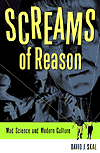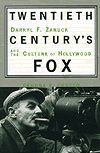Robert Siodmak
by Deborah Lazaroff Alpi
McFarland,
412 pps., library binding, $55
[ Buy this book through www.amazon.com ]
Robert Siodmak (1900-1973) ranks high among the brilliant pictorial stylists who brought ideas from German Expressionism to the United States and successfully melded them into American cinematic tradition. He never became as renowned as Fritz Lang or the German-influenced Briton Alfred Hitchcock, but his best work is on par with either of these masters. Siodmak was a particularly strong influence in the Forties during the flowering of that particular form of moody drama now known as film noir.
Although Siodmak has been profiled in numerous articles in English and American books and magazines, and larger works in Europe, this is the first large-scale study done in English. The author provides a biographical study and comprehensive coverage of Siodmak's moviemaking: his pre-directorial efforts in Germany, which began in 1927; his decade of successful directing in the Berlin studios; his rise through the B-picture ranks in America to a recognized mastery of film noir; and his later decline in Europe. Far greater emphasis is placed on his noir films than the others, with good reason — he did his best work in that genre.
Siodmak's noir works are strong on suspense, feature great photography, and are notable for being cast against type: Phantom Lady retells the William Irish novel with Franchot Tone as a paranoid killer; Christmas Holiday has fine dramatic performances from musical comedy stars Deanna Durbin and Gene Kelly; in The Suspect, Charles Laughton portrays a sympathetic murderer; The Strange Affair of Uncle Harry features George Sanders as a small-town introvert; The Spiral Staircase includes Dorothy McGuire as a mute girl and George Brent as a serial killer; The Dark Mirror offers Olivia DeHavilland as good and bad twins; The Killers introduces Burt Lancaster as a doomed ex-gang member; and The File on Thelma Jordon plays up a lethal Barbara Stanwyck. All of these pictures are covered in admirable detail in Alpi's book, which also includes cast lists, credits from Siodmak's 56 films, and a fine bibliography.
Screams of Reason
by David J. Skal
W.W. Norton,
368 pps., hardback, $29.95
[ Buy this book through www.amazon.com ]

Subtitled Mad Science and Modern Culture, David Skal's latest venture into the dark side of the movies deals with the perennial villains of imaginative melodramas — mad scientists — and provides an amusing and chilling odyssey. The author even parallels these fictitious fiends with some real-life counterparts, such as the Unabomber. In fact, some of the ideas conceived by the screen's nutty scientists have proven quite prescient. Skal notes, for example, that Dr. Jean Rosenbaum of New Mexico came up with the idea for inventing the cardiac pacemaker from the 1931 movie Frankenstein.
Science-fiction and horror films are wisely considered together, in recognition of their close relationship. The most famous balmy (or, at least, bemused) scientists of literature and cinema — Frankenstein, Dr. Jekyll and Mr. Hyde, Jack Griffin (the Invisible Man) and Dr. Moreau — are given the royal treatment; lesser savants such as Drs. Thorkel (Cyclops), Mirakle, Gogol and Xavier step briefly into the spotlight.
The author makes the sensible point that the fictional mad scientist is a necessary steam valve for a populace increasingly bombarded by deranged science in its everyday life. Skal's writing skill and a well-established penchant for meticulous research are evident throughout this well-illustrated tome.
Twentieth Century's Fox
by George F. Custen
Basic Books,
435 pps., paper, $27.50
[ Buy this book through www.amazon.com - Paperback ]
[ Buy this book through www.amazon.com - Hardcover ]

The mere mention of Darryl F. Zanuck conjures up vivid images memories of the notoriously abrasive, jodhpur-wearing martinet who ruled Twentieth Century Fox with a polo mallet, tough language and an iron fist. Add to the lore some embarrassingly public romantic entanglements and it's plain to see why he was never accorded the acclaim or "good press" given to Irving Thalberg or David O. Selznick. The fact that Zanuck probably contributed more important innovations to the movies than any of his more smooth-edged rivals is convincingly set forth in this new biography.
Custen details Zanuck's days at Warner Bros., where he produced the most influential early sound film (The Jazz Singer), and started the cycle of hard-hitting gangster pictures (Little Caesar, Public Enemy), social problem exposés (I Am a Fugitive from a Chain Gang), more virile musicals (42nd Street), and prestigious biographical films. He later ran his own company, Twentieth Century, which merged with Fox Film to create one of the world's largest studios, where he produced many outstanding pictures. As a starmaker, he initiated or furthered the careers of James Cagney, Edward G. Robinson, Barbara Stanwyck, Shirley Temple, Tyrone Power, Betty Grable and many others. Zanuck's provocative life makes for quite good reading.
[ Go to the top ]